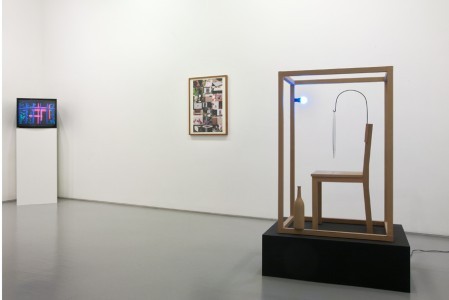Torbjörn Vejvi
25 Nov 2011 - 27 Jan 2012
TORBJÖRN VEJVI
Matter Matter Physically Dead
25 November, 2011 - 27 January, 2012
“Matter Matter Physically Dead” is the fourth exhibition by Torbjörn Vejvi (Växjö, Sweden, 1972 – lives and works in Los Angeles) at the Raucci/Santamaria Gallery in Naples. Vejvi realizes his sculptures using simple and light materials such as wood, cardboard, fabrics, creating structures that reveal subtle existential relationships between form and memory, introspection and everyday life. The exhibition comprises a video, two sculptures, and several collages. The video was shot seven years ago in the now disused Los Angeles Zoo, located in the same park as the famous Hollywood sign. Without permission, at dawn, the artist entered the empty animal cages, hanging inside them, with transparent threads, a series of brightly coloured geometric wooden sculptures. The idea to use colourful hanging objects is inspired by a comment of Jean-Luc Goddard’s, who, speaking about his film “Contempt” (1963), identified colour as an armature that sustains and supports that film's mise-en-scène. In Vevji’s video, images of the cages follow each other, with the colours and geometries transforming the sequence into a sort of narrative sculpture. The absence of animated life and the abjectness of these partially abandoned spaces clash with the man-made impositions of geometry and vivid colour, focusing the ambiguities of the relationship between man and animal, nature and culture. The soundtrack (making a direct nod to Goddard in that it is partly transcribed from the famous soundtrack of "Contempt") performed on organ and guitar by Mark Lightcap, accents the ambiguity and alleviates the sensation of emptiness. This theatrical treatment, which is a cornerstones of Vejvi's language, suggests a dimension that is uncontained by real life. Both of the two sculptures relate to the video like a lost memory or a past thought. One sculpture displays a trio of figures--a man and a lion contemplating a more amorphous figure in a cell--to parallel the video’s concerns while approaching them from another vantage in a self-contained work. Transposing into three dimensions the idea of an art that is caged or behind bars, the sculpture performs metaphorically, as a description of the stage in which any work of art contemplates its own existence. The second sculpture plays off the video’s concept of a dichotomy between inside and outside, freedom and constraint, physical and non-material, presenting a sort of wooden cage, inside of which are a chair, light bulb, cigarette, bottle, and a circular photograph of a series of gates. This people-friendly cage suggests a sort of thinking corner in which symbols of vice and neuroses co-exist.
Matter Matter Physically Dead
25 November, 2011 - 27 January, 2012
“Matter Matter Physically Dead” is the fourth exhibition by Torbjörn Vejvi (Växjö, Sweden, 1972 – lives and works in Los Angeles) at the Raucci/Santamaria Gallery in Naples. Vejvi realizes his sculptures using simple and light materials such as wood, cardboard, fabrics, creating structures that reveal subtle existential relationships between form and memory, introspection and everyday life. The exhibition comprises a video, two sculptures, and several collages. The video was shot seven years ago in the now disused Los Angeles Zoo, located in the same park as the famous Hollywood sign. Without permission, at dawn, the artist entered the empty animal cages, hanging inside them, with transparent threads, a series of brightly coloured geometric wooden sculptures. The idea to use colourful hanging objects is inspired by a comment of Jean-Luc Goddard’s, who, speaking about his film “Contempt” (1963), identified colour as an armature that sustains and supports that film's mise-en-scène. In Vevji’s video, images of the cages follow each other, with the colours and geometries transforming the sequence into a sort of narrative sculpture. The absence of animated life and the abjectness of these partially abandoned spaces clash with the man-made impositions of geometry and vivid colour, focusing the ambiguities of the relationship between man and animal, nature and culture. The soundtrack (making a direct nod to Goddard in that it is partly transcribed from the famous soundtrack of "Contempt") performed on organ and guitar by Mark Lightcap, accents the ambiguity and alleviates the sensation of emptiness. This theatrical treatment, which is a cornerstones of Vejvi's language, suggests a dimension that is uncontained by real life. Both of the two sculptures relate to the video like a lost memory or a past thought. One sculpture displays a trio of figures--a man and a lion contemplating a more amorphous figure in a cell--to parallel the video’s concerns while approaching them from another vantage in a self-contained work. Transposing into three dimensions the idea of an art that is caged or behind bars, the sculpture performs metaphorically, as a description of the stage in which any work of art contemplates its own existence. The second sculpture plays off the video’s concept of a dichotomy between inside and outside, freedom and constraint, physical and non-material, presenting a sort of wooden cage, inside of which are a chair, light bulb, cigarette, bottle, and a circular photograph of a series of gates. This people-friendly cage suggests a sort of thinking corner in which symbols of vice and neuroses co-exist.

